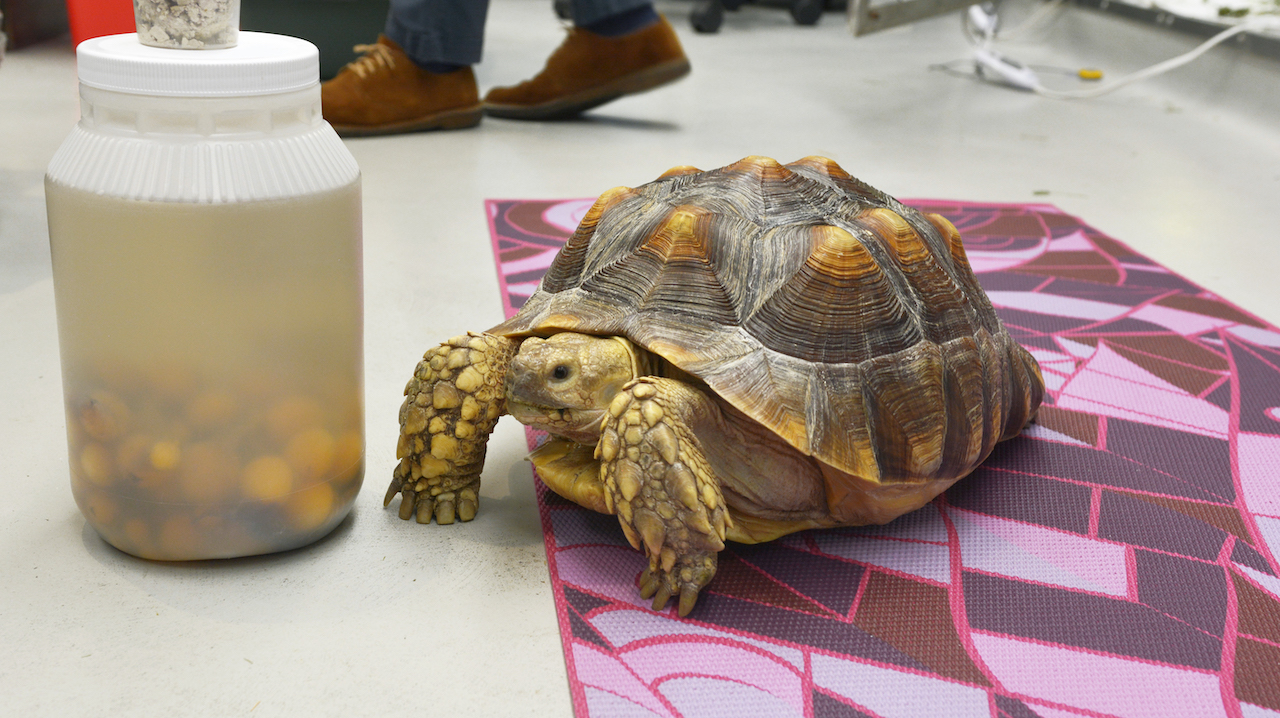Veterinarian performs new surgery on tortoise at Cornell
Very few tortoises are as lucky as Jimmy Padrone. Not only does the 13-year-old, 19-pound Sulcata tortoise live the good life with her family in Hawley, Pennsylvania, but she was the first tortoise at the Cornell University Hospital for Animals (CUHA) to undergo a cutting-edge procedure to remove a bladder stone.
The first clue that something was wrong with Jimmy was that one of her legs was dragging. Eventually the other leg started doing the same thing. “She couldn’t really lift herself up and walk,” says her owner, Robert Padrone.
The Padrones had only recently moved to the area, so they weren’t sure where to take Jimmy. Fortunately, a local pet store was able to recommend a veterinary clinic that treats reptiles. After an initial examination, the vets there suggested they take her to CUHA.
“It’s quite common for this species of tortoise to have urinary stones,” says Dr. Nicola Di Girolamo, who recently joined CUHA’s exotic pet service and performed Jimmy’s surgery.
Historically, to remove urinary stones from a tortoise, Di Girolamo explains, veterinarians would cut a large piece of the bottom part of the animal’s shell to get access to the stone. After that, they would have to reattach the missing part of the shell, which isn’t always easy.
A tortoise’s shell is composed of bone and has nerve endings. “Cutting [the shell] is very painful for the animal,” says Di Girolamo. “It can result in a lot of complications. Sometimes these stones are so large that you can't take them out even if you open the shell.”
Instead, Di Girolamo performed a prefemoral cystotomy, a surgical technique he utilized while working in Hong Kong, where pet tortoises are common. The procedure involves turning the tortoise on its side (with the standard procedure the animal remains upright). “That way, thanks to gravity, the stone moves towards the leg of the tortoise,” says Di Girolamo. “Just by cutting into the skin in the front of the leg, we can get to the urinary bladder, open the urinary bladder, destroy the stone, and get it out,” he says.
“Different versions of this technique have been performed by other veterinarians, but we modified this technique by changing the positioning and adding an additional retractor that prevents the urates — the crystals that make up bladder stones — from contaminating the surrounding tissue, hence reducing the risk of postoperative complications.”
Jimmy’s bladder stone was 10 cm in diameter (roughly 4 inches). To get the stone out, the veterinarians used a drill to crush it into small pieces and then removed those with a pair of forceps.
But removing the stone wasn’t the end of it. Jimmy’s initial CT scan also revealed that Jimmy was in fact a she (the Padrones had originally thought the tortoise was a he). She was able to be spayed at the same time via the same incision in the leg. (It can be very difficult to accurately sex a reptile just by looking.) In total, the surgery took around five hours. After a week recovering at the hospital, the tortoise was ready to go home.
The staff a CUHA called the Padrones every morning and every evening to give them an update. “We knew Jimmy was feeling better when the people taking care of her would pick her up and she would pee all over them,” says Padrone. “It was rough on them, but it showed that she was starting to function correctly.”
As of her last checkup, Jimmy was back to her normal self. “She runs the house,” says Padrone. “She’s a tortoise, but she’s a member of the family.”

Padrone says they could not have asked for anything to work out better for Jimmy. “We were just plain lucky that everything fell in into place and so was Jimmy,” he says. “By sheer luck we went to Cornell and got Dr. Nic. I mean, to be placed with the doctor who just invented this new procedure. It was unreal. And everyone we dealt with — you could see that they cared about Jimmy. She got the best care possible.”
Di Girolamo says he plans to speak about prefemoral cystotomy at a large veterinary conference later this year. “Hopefully, this is going to become the standard of care so that, going forward, tortoises won’t have to undergo a very risky and invasive surgery.”
Written by Christina Frank




